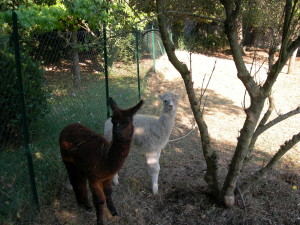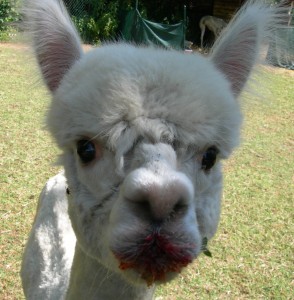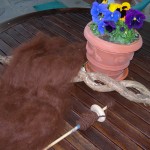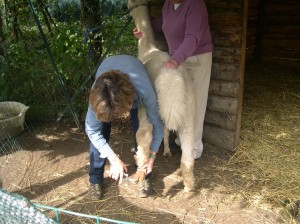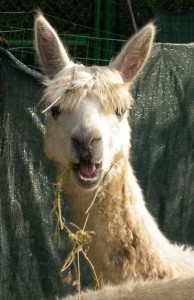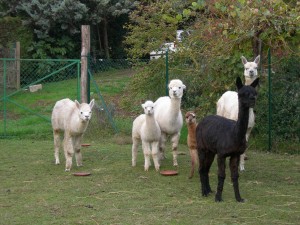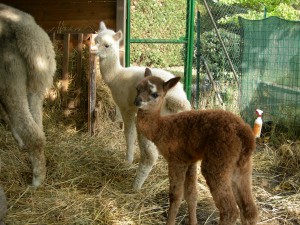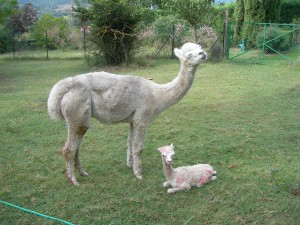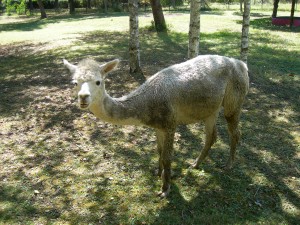Little Pomino, a white male huacaya, was born on May 17th this year, a date that is indelibly engraved on my heart as it is also the day my husband died. So I had tears of happiness and tears of grief on one momentous and overwhelming day. For obvious reasons, that makes Pomino a very special alpaca.
He is already far more sociable and affectionate than the others. His friend Merlot was born the following day and despite identical treatment and upbringing, they are completely different. Merlot is a dark brown Suri, shy and nervy like his mother Champagne, and very beautiful. Pomino, on the other hand, doesn’t mind being cuddled and kissed on his small nose and is curious and tame.
A few weeks ago, I noticed that Pomino’s left eye was swollen and closed. He seemed to have had some kind of sudden unexplained injury as I had checked him a few hours earlier and he was absolutely fine. I bathed the eye with camomile tea and didn’t get too worried.
When the eye didn’t improve I contacted the vet who examined it and told me he had a bad corneal ulcer. I had to inject him daily with antibiotics and give him eye drops and topical pain relief.
To my horror and distress, that didn’t work either and his eye got progressively worse and resembled a small volcano. I called the veterinary opthamologist (yes, there is such a thing!) who came out immediately and examined poor Pomino. The diagnosis was my worst nightmare. The ulcer was a kind known as a melting ulcer and had basically destroyed his eye. The only option was to have it removed.
I was desperately upset that this little creature was going through such pain, that I was having to cause probably more pain treating him. I was also petrified that he would die during the operation as the danger is not from the procedure, which is relatively straightforward, but from the anaesthetic, which for an alpaca, is not. I was reeling from the loss of my husband, then my elderly Labrador, surely Pomino wouldn’t be taken from me as well?
As August is the holiday period in Italy the opthamologist wasn’t able to do the operation, but my wonderful horse vet Simone was. He contacted a colleague from Bologna who was an expert anaesthetist and, more importantly, had worked on alpacas before. She also brought another specialist colleague with her.
Naively I thought they would be able to do the operation in my paddock, but Simone told me it was far too serious for that and he would have to be taken to his surgery. This in itself presented another nightmare for me, as I had no idea how to get him there, plus alpacas can’t do anything on their own, so I would need to take his mother Emilia there too. Fortunately Simone was a real star and organised transport too, in the form of Mauro and his horsebox which was so well equipped he even had a camera fixed up so he could see how the animals were from his Landrover while he was driving!
I was in a terrible state on the day of the operation, convinced that Pomino would die under the anaesthetic. My friend Kathy and her daughter Kaitlin came with me and took my mind off things as we sat in the lovely grounds of the vet’s surgery from three o’clock until almost seven o’clock.
All went well, Pomino was fine and was even feeding from his mother within half an hour of coming round from the anaesthetic. I was so relieved I thought I would faint! I could have kissed the vet.
So now, three weeks on, Pomino is doing well and doesn’t seem bothered by having just one eye. He is still adorable and very cute and starting to trust me again, now he knows I am not going to inject him or try to do other nasty things to him every time I come near him.
I am philosophical about why this happened.Maybe he is going to serve as an inspiration for children with a similar handicap. I don’t know. All I am grateful for is that he has come out of this in good health and, to me, is more beautiful than ever.
